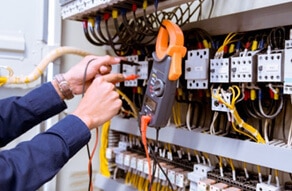Call us now
0439 823 190What Is The Difference Between Volts, Amps & Watts?
Posted on November 14, 2020

Volts, amps and watts are measurements of electricity to measure how powerful and efficient an electrical system is. Along with measuring the electrical power of electrical circuits and devices they also help with knowing how resort they are. Here at The Local Electrician, our Emergency Electrician team knows how to measure and apply volts, amps and watts.
Measuring electricity is done through volts, amps and watts each with their own use. Volts measure the force and amps are what measure the flow of electrical currents. Watts are a measurement of the amount of energy used and is calculated by multiplying volts with amps.
What are Volts?
Volts are the base unit of voltage and measure the potential difference between two points. This unit of electric potential shows the difference in the electrical circuit. It refers to the electrical pressure inside a circuit and is measured in volts. When the volts increase then the current will increase as well.
This current will flow through the system in a loop and if the circuit is not broken. A broken circuit, such as a switch, will have the power dissipated. One voltage is the difference in electrical potential among two different points within a circuit or wire.
Below is a guide on different devices and systems and their voltage levels.
| Object or Device | Voltage (V) |
| Rechargeable Battery | 1.2 |
| Non-Rechargeable Battery | 1.5 |
| USB | 5 |
| Automobile Battery | 2 |
| Electric Vehicle Battery | 400 |
| Household Battery | 230 |
| Rapid Transit Third Rail | 600-750 |
| Electric Power Lines (High Voltage) | 110,000 |
| Lightning | 100,000,000 |
What are Amps?
Amps, or ampere, are the base unit for electrical currents within the International System of Units. They measure the electric current within the electrical systems and the volume of how many electrons are present. How much electricity or electrical energy is provided within one line is what this unit measures.
What are Watts?
Watts are described as the base unit of the electrical power within electrical systems. It will measure the amount of energy released within a system per second. The amount of voltage and current within the system will determine how many watts are made. If the wattage is higher this means that there is more electrical energy and power being produced.
How to Calculate Watts?
To calculate how many watts a device or system has, knowing the amps and volts is needed. The amps are how much power is being consumed where the volts is measuring the pressure of the electrical current. Multiplying the amps and the volts together will create the result of how many watts are being generated. Such as 2 amps by 150 volts, or 2A x 150V, will result in 300 watts, or 300W.
Another method is to find a reliable wattage calculator online which will do the calculations automatically. Entering the figures often creates an accurate result but it should not always be completely trusted. Also, some calculators might have appliance and device types to allow the process to be easier.
Why Knowing Watts is Important?
Knowing about wattage will help with choosing appliances which will use less energy and save more money. Watts measures how much energy is used and with appliances shows how much energy they will consume. The electrical bill is often calculated by how many watts or energy was consumed.
Appliances which are rated show how much energy the applicant will need to function correctly. When wanting to become more energy efficient it is recommended that appliances which need fewer wattages are preferred. Knowing how many watts is also important if solar panels are being installed to see how many and which ones should be used to power the home.
Here is a general guide on appliances and their average wattage usage.
| Device or System | Cost per hour | Energy Consumer |
| Heat Pump or Central Aircon | $2 | 15,000W |
| Hot Water System or Clothes Drier | 0.55 Cents | 4,000W |
| Water Pump | 0.40 Cents | 3,000W |
| Heater | 0.20 Cents | 1,500W |
| Hair Drier | 0.16 Cents | 1,200W |
| Electric Stove | 0.14 Cents | 1,000W |
| Fridge | 0.14 Cents | 1,000W |
| Computer with Monitor | 0.05 Cents | 400W |
| Light Bulb | 0.008 Cents | 60W |
AC and DC Power Systems
AC and DC are the currents which transfer electricity within an electrical system. Alternating currents will switch the direction of the electricity while direct currents have it in one direction. The type of system will determine which electrical current would be applied. We encourage reading our blog ‘alternating current vs direct current’ to know more on the positives and negatives of each system.
Professional Electricians Working in Sydney
Here at The Local Electrician, we offer reliable 24 hour electrical services to every person living within Sydney. Our team are qualified experts who understand how volts, amps and watts function in a system. We will be able to perform all kinds of repairs and installations knowing how these work and how to work with them. We can also provide insights and recommendations on systems which are efficient with their wattage usage.
The emergency electricians working across Sydney, including Inner West and North Shore, are experts with volts, amps and watts. Our Level 2 Electrician service is here for Sydney where we follow the Safe Work Australia guidelines to complete jobs perfectly.

Contact The Local Electrician today on 0439 823 190 for on time and professional emergency electricians!
Lifetime Warranty on Workmanship and Labor
Our Services
Our skilled electricians are qualified to carry out any electrical repair or installation within Sydney. We strive to deliver absolute customer satisfaction by offering electrical services that are affordable, safe and long lasting.
- Private Power Pole Installation: What Sydney Homeowners Need To Know - November 29, 2023
- Understanding Power Outages: When To Call a Level 2 Electrician - November 14, 2023
- Understanding Level 2 Electrical Needs: FAQs for Sydney Homeowners - October 7, 2023
Our Level 2 Local Electrical Services










